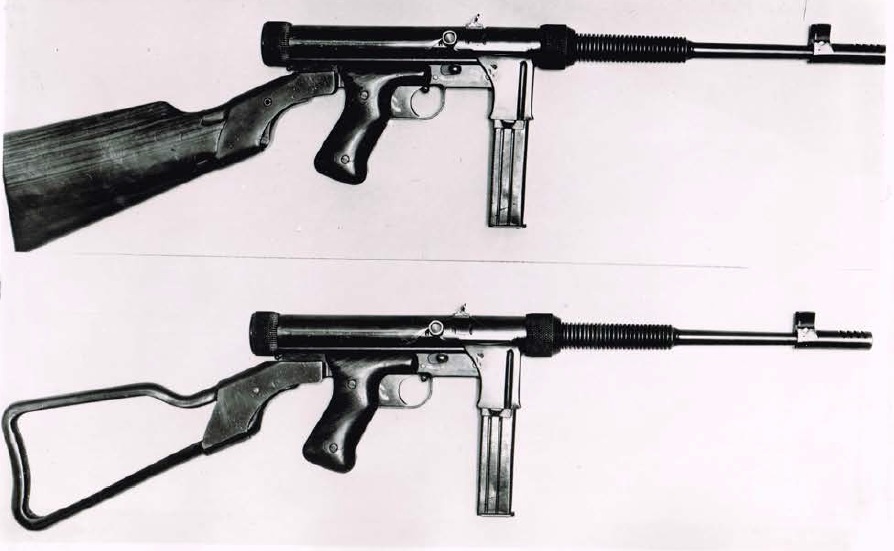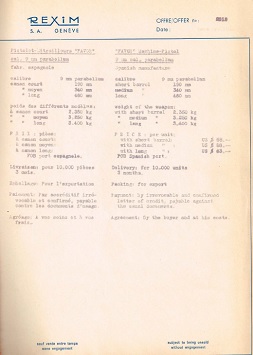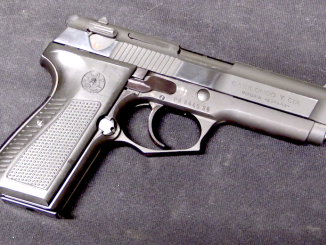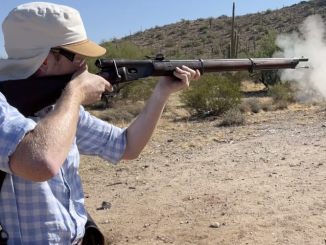The Rexim-Favor was a Spanish-made, Swiss-marketed, and allegedly French-designed submachine gun produced during the 1950s. Only about 5000 were made in total, as the gun failed to procure any significant military or police contracts. Mechanically, it was a pretty typical submachine gun, using a simple blowback mechanism chambered for 9mm Parabellum ammunition. It had a quick-detachable buttstock, and of some interest an easily removeable barrel as well. The barrel was secured by a large external nut which allowed quick removal for transport or changing of barrels. It also fired from a closed bolt, which is a bit atypical for guns of this type. That allowed better practical accuracy, but was also much more expensive to manufacture.

It was striker-fired, with a selector switch allow semiauto and fullauto modes. It was available in three different barrel lengths: the “Police” (19cm/7.5in), the “Commando” (34cm/13.4in), and the “Sniper” (46cm/18.1in). All versions included a integral muzzle brake. The rate of fire in fully automatic was 600 rpm, and the guns fed from MP-40 magazines (a thoughtful use of readily available magazines).

The guns were sold and marketed by the Swiss company Rexim S.A. of Geneva, which subcontracted the production out to the La Coruña factory in Spain. They were made from 1952 until 1957, at which point lack of sales put Rexim S.A. out of business. Advertised price of the guns was $58 for the short or medium barrel, and $63 for the long barrel (in US dollars, FOB from a Spanish port). That would be equivalent to roughly $500-$550 today.

The manual (or sales brochure; it serves both functions) is interesting to read for a couple reasons. It makes clear the company’s eager and somewhat questionable claims for the gun, and it is written in an odd poorly-translated English. For example, the gun is described as being ideal for police, commandos, infantry, paratroops, armored vehicle crews, and (with the optional bipod) for use as a light machine gun. To quote The Outlaw Josie Wales, “it can do most anything!”. The literature makes it clear that Rexim would happily accommodate any reasonable special request as well, and one such version not mentioned in the manual included a bayonet clearly copied from the MAS-36 and FG-42 rifle, stowed under the barrel.
Most of the text is a bit awkwardly worded but understandable. Some bits, however, are almost hopelessly muddled. For example:
The breech-case is composed of a steel tube with cuttings for the mechanism, the support of the bridge-shelf, the shutting-bushes, and the half-rotative impermeability-shutter.
Wow…sounds like some German terms got translated into Spanish and the on to English, all by barely-fluent speakers.
Anyway, you can see the whole document for yourself here:





I don’t know why, but when I look at this thing, I think of Gypsy king… bamboleo, bambolea…:-)
Sorry guys, just got carried away.
Looks like a Sten and a Thompson had a drunken night out and nine months later …
…. in addition to its Spanish flair. That’s what I was getting to in previous remark. Gypsy part of is obvious – at home everywhere, but nowhere.
Do you have any idea whether the buttstock was folded or rather it was fixed?
Only fixed stocks were available, as far as I can tell.I stand corrected – see eon’s comment.
Re stocks, there was a folding stock version;
http://i405.photobucket.com/albums/pp139/Billhag/ReximFavor01.jpg
But it seems the one they were pushing had a rather unusually-“elegant” fixed stock;
http://world.guns.ru/userfiles/images/smg/smg141/rexim_fv_1.jpg
For years this version was the one most commonly seen in photographs in books on firearms. I’m wondering if it was an “official portrait” one-off.
I’m also wondering why an SMG with a full pistol grip needs a semi-pistol-grip style fixed butt. Was the shooter supposed to shift his off hand back to the stock wrist to execute a bayonet thrust?
There seems to have been a lot of “options” on this weapon; barrel jackets, folding stocks, at least two different bayonet attachments (one looking suspiciously like that of the Kar98k), etc.
(A Google image search for “Rexim-Favor SMG” dredges up a lot of very odd “variants”, to say the least.)
I’m wondering if the idea was to let the customer order a gun tailored specifically to their “needs”, or at least their theories on the way an SMG should be used.
The fancy-stocked one might have looked nice on parade, for instance.
cheers
eon
Did Favor by any chance make sporting/hunting guns? Because that stock looks like it came right off my Sako Deerhunter
Probably the manual got translated from French to Spanish and then to English. Geneva is firmly in the French speaking region of Switzerland and officially monolingual. The locals understand English better than German (I know that also from personal experience).
The gun itself… 460mm barrel on a 9mm Para SMG? Even with “hot” SMG ammunition I would guess that the muzzle velocity of the “Sniper” and “Commando” versions was virtually the same. I do like the unique looks of the thing and firing from a closed bolt would have made it a good police SMG, at least in theory. I wonder what was wrong with it.
As for your last question, I guess timing and availability of better SMGs (either cheap WWII surplus or state-of-the-art ones) around the late Fifties. I recall seeing reading something about the Rexim-Favor having been offered to South American militaries and perhaps to Portuguese and Spanish ones too, but right now I am half a continent away from my library and cannot pin point the exact reference.
According to Hogg ( Military Small Arms of the 20th Century,6th ed.), the R-F firm marketed the gun until they went bankrupt in 1957, after which it was marketed under the name “La Coruna” by the Spanish manufacturer. Apparently it finally vanished from the market some time in the early-to-mid 1960s.
The only actual official users were the Turkish national police, and they were still issuing them in the early 1980s.
Odds are there are still some in their armories even today.
I’m rather surprised they didn’t show up on the old “Man From U.N.C.L.E.” TV series as a THRUSH weapon.
I remember one first season episode in which Mr. Waverley led a raid to pull Solo & Kuryakin’s chestnuts out of the fire, and was rather surprised to see that the agents in business suits backing him up had either CETME Model 58s or Model Cs in 7.62 NATO. (Or maybe they were early-model HK91s?)
And male HQ personnel carried FN HP 9mm pistols. (The ladies got Beretta M1934 .32s.)
The production company apparently had at least one “technical advisor” or whatever who knew small arms.
cheers
eon
A security force named “Turkish National Police” and with Spanish Rexim-Favor SMG ?..
Never heard about.
One issue nobody seems to have brought up is the problem that seems to have been inherited from the MP-40 and the Sten. The pistol grip for your dominant hand is fine but the other hand must Rexim-Favor by the magazine well (unless you want to wear a Kevlar glove and grab the barrel fins). The usual implication of the magazine well acting as a fore-grip is that untrained users would hold the magazine rather than the well, causing the magazine to deform and thus jam the gun-not something you want to happen in the middle of a street-fight.
This would probably fit in Herge’s The Adventures of Tintin…
I suspect that unusually long magazine housing (about twice the normal length)was intended to prevent that recurring problem with conventional layout SMGs. Most people holding an SMG that way tend to “choke up” on the magazine, holding it just under the receiver/barrel group. (I’ve done that with the M3A1 and the MP40.)
If you grab the Rexim-Favor that way, you have a firm grip on the magazine well “tube” itself, not the magazine box. Unless that well is irrationally thin sheet metal, it’s unlikely to deform or to allow the magazine to be “canted” aft by your grip.
The Argentine MEMS Model 52/58, 52/60, AR63, and M67 9mm SMGs had a similar setup with their magazine housings, which are even longer than the Rexim-Favor’s. Its purpose is pretty obvious when you look at the final Model 67 version (second one down from the top in the illustration, the M52/60 is the top one);
http://www.earmi.it/armi/atlas2/632.gif
The M67’s stamped-steel magazine housing is shaped and checkered like the pistol grip of a 1911.
For conventional layout SMGs, this is such a sensible design feature that I’m surprised that it hasn’t been used more often.
cheers
eon
I like Eon’s hard-headed approach in his commentary about the Rexim-Favor. He points out certain favorable features that tend to be overlooked by most. I suspect that this weapon, given sufficient exposure and acceptance in a more receptive market, would have been better appreciated for its virtues in spite of the maker’s marketing hype and somewhat far-fetched applications ( which were an almost sure sign of desperation given the circumstances of the time ). Perhaps I am the odd one out on this, but the Rexim-Favor also appeals to me from an aesthetic standpoint — slim, compact and graceful yet purposeful in its demeanour. I will also be the first to say that beauty is in the eye of the beholder :).
Well said. Would this gun have been a good blank-firing movie prop without chopping off the barrel and the magazine well?
Generally, the only issue with blowback, advanced-primer ignition SMGs in this role is feed geometry. Simply put, some “subguns” just don’t like the nose profile of blank cartridges.
For the most part, a lighter recoil spring and/or a bore restrictor will get the job done with pretty much any straight-blowback design, including pistols.
Short recoil designs are another matter. For instance, the Colt .45 1911 was always a PITA to get to work with theatrical blanks. So much so that Hollywood ended up either not using it or dodging the issue.
The other day, I was watching an old movie titled “Queen of the Amazons” (1946), which was a typical “explorers vs. lost tribe” sort of thing. And the explorers were using .45 Colts. But when they fired them, you could see that the slide never cycled.
Later on, for instance in the TV series “Voyage to the Bottom of the Sea”, the issue was dealt with by substituting Star Super A 9mm 1911 “copies” (actually closer to an FN HP internally), which worked perfectly well with 9mm blanks and the usual modifications. They can be spotted by their bar-type external extractor on the right side of the slide, much like a late-model P-35; no other 1911 “variant” had that setup at that time, although quite a few 1911 clones use it today.
cheers
eon
“Generally, the only issue with blowback, advanced-primer ignition SMGs in this role is feed geometry.”
I believe that most of the experts agree that “API” in submachine guns (open bolt) is a theoretical “legend”, not occuring in practice (and it hardly could, given the max. firing pin length of 1.5mm,of which you spent at least 1mm just to detonate the primer)
The said “phenomena” exists only in specially constructed automatic cannons that have a longer chamber and a mechanism that detonates the primer of a round, while round is still traveling in chamber.
I think it would have, come to think of it — great idea, Andrew!
According to the Internet Movie Firearms Database, the Rexim Favor was used in the movies The Beast Must Die, Star Wars and Alien.
http://www.imfdb.org/wiki/Rexim-Favor_Mk5
I have seen Alien half a dozen times, but I have never even noticed they had pistols, since they are not used in the movie for some reason. I suppose Scott (the director) thought it more effective if their only real weapon was the makeshift flamethrower, and I have to agree, even if it creates a plot inconsistency. If you look at the screen captures and prop photos it’s pretty clear that the Rexim Favor was used, although heavily modified as typical to Hollywood scifi movies.
I don’t remember if thats adressed in a film, but plausible explanation would be that using projectile firing weapons inside a ship would be prohibited by their companys standard of procedures, since of a great risk of damaging the ship hull it poses.
And they really liked to follow regulations and rules, like when Ripley (in Dir. cut ?) initially refused to open the doors when they brought the face huggered member back from their misfortuned scouting of the “spacejockey” derelict ship (which ironically doomed them all)
Also, remember Aliens, and scene where guy confiscated the magazines of a squad when they entered the atmosphere processing station, and commanded using only flamethrowers.
Oh, such great SF scenarios and movies…
Hard to beat with all of the today “gravity is everything” junk and BS.
Very similar linguistic nonsenses are often found in firearms patents, making very hard to understand and decipher the functioning of said patent applicatons.
Possibly it is made intentional, to confuse the would-be patent “stealers”.
You have a good point there, although I think that in most cases, the translation tends to be unintentionally literal through no fault of the translator, and with little account being taken of the subtler nuances of language, which in turn results in the unfortunate text one so often encounters. It is very difficult, even for a skilled translator, to fully convert and convey many of the actual intended meanings across this language barrier.
I want my next firearm to have a half-rotative impermeability-shutter.